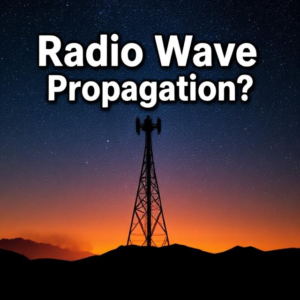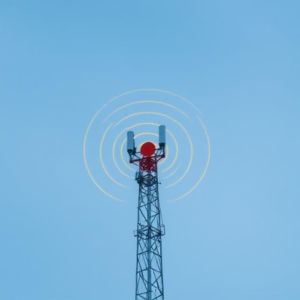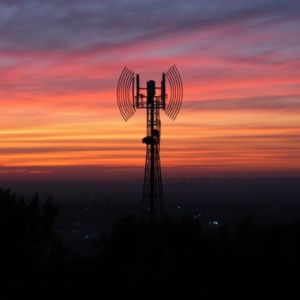What is Radio Wave Propagation?
Radio wave propagation is the way radio waves travel through the air (or other mediums like space or water) from one place to another. Think of it like sending out ripples in water, except with invisible waves that carry information.
Radio waves are a type of electromagnetic wave (like light or X-rays) that can travel through space. These waves can carry all kinds of information, such as voice (like in a radio broadcast), data (like Wi-Fi or Bluetooth), or video (like in TV broadcasting).

There are a few factors that affect how radio waves travel:
- Frequency: Radio waves can have different frequencies (how many times the wave goes up and down per second). Lower frequency waves travel further but can be blocked by objects, while higher frequency waves carry more data but don’t travel as far.
- Atmosphere: Radio waves are affected by the air, weather, and even the earth’s surface. For example, storms, buildings, and mountains can block or bend the waves.
- Line of Sight: For some frequencies (like with TV or cell phones), the radio waves travel best when they can “see” the other end—this is called line of sight. If there’s an obstacle like a mountain or building in the way, the signal might be blocked.
- Refraction and Reflection: Radio waves can bend or bounce off objects. This means that if a wave hits a building or the ground, it might reflect and travel in a different direction.
- Ground Waves vs Sky Waves:
- Ground Waves: These hug the earth’s surface and are good for local communication, like AM radio.
- Sky Waves: These can travel far by bouncing off the ionosphere (a layer of the atmosphere) and are used for long-distance communication, like shortwave radio.
What is an Antenna?
An antenna is a device that allows radio waves to either enter or leave a system. It helps send and receive radio waves, converting electrical signals into electromagnetic waves (for transmission) and vice versa (for reception).
In simpler terms, an antenna is like a “bridge” between the electrical system of your device (like your phone or radio) and the air around it, where radio waves travel.
Types of Antennas and Their Functions:
- Dipole Antenna:
- How it works: This is one of the simplest types of antennas. It consists of two metal rods (like a stick on each side), and it works by creating an electric field that radiates out in the form of radio waves.
- Use: Commonly used in many radio stations and for simple TV antennas.
- Monopole Antenna:
- How it works: This is like half of a dipole antenna, usually mounted vertically above a ground plane (like a metal surface or the earth). It uses the ground as a reflective surface to send out signals.
- Use: Often used in car radios and mobile communication.
- Yagi-Uda Antenna (Yagi Antenna):
- How it works: This is a directional antenna that can focus radio waves in one direction, like a flashlight beam. It has multiple elements (like rods) that help focus the signal.
- Use: Often used for long-distance communication, like for TV reception or amateur (ham) radio.
- Parabolic Antenna (Dish Antenna):
- How it works: It looks like a satellite dish. The parabolic shape helps concentrate signals in one direction to receive or send signals over long distances. It’s very good at focusing signals from one point to another.
- Use: Used for satellite communications, Wi-Fi hotspots, and radar systems.
- Patch Antenna:
- How it works: This is a flat antenna that’s small and compact. It uses a flat metal surface to send and receive radio waves, often mounted on devices like cell phones or Wi-Fi routers.
- Use: Common in wireless communication systems like Wi-Fi, Bluetooth, or GPS.
How Do Antennas and Radio Waves Work Together?
- Transmission (Sending Signals):
- When you want to send a signal (like a radio station broadcasting), an electrical signal is sent into the antenna.
- The antenna then converts the electrical energy into radio waves (electromagnetic waves) that travel through the air.
- Reception (Receiving Signals):
- When you’re receiving a signal (like listening to the radio), the antenna picks up the radio waves from the air.
- The antenna then converts those radio waves back into electrical signals, which are passed to the device (like a radio or phone) to process.
Radio Wave Propagation in Action:
Imagine you’re listening to your favorite radio station. Here’s what happens:
- The radio station sends out radio waves (electromagnetic waves) from its large antenna.
- These radio waves travel through the air, sometimes reflecting off buildings, bending around obstacles, or traveling through the ground.
- Your car’s radio antenna (or the one in your home) receives the waves, and your radio converts them back into sound so you can hear the music or news.
If you were farther from the station, the signal would be weaker, and your antenna might need to be bigger or more powerful to receive the waves clearly.
Key Takeaways:
- Radio wave propagation is how radio waves travel from one point to another. It’s affected by things like frequency, weather, and obstacles.
- Antennas are devices that send and receive radio waves, allowing communication with radios, cell phones, TVs, and more.
- There are different types of antennas, and each is designed for a specific purpose, like broadcasting, focusing signals, or receiving data.











